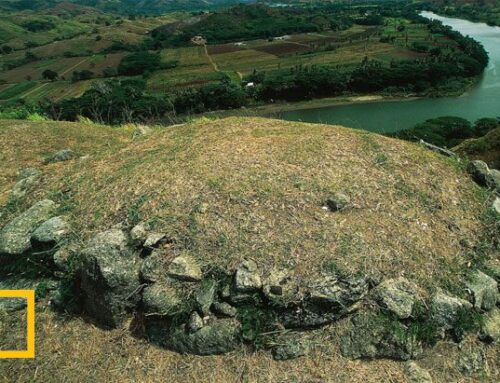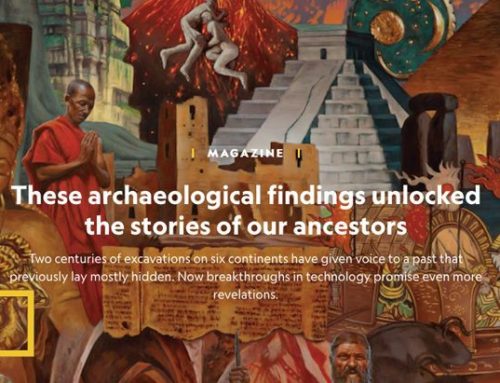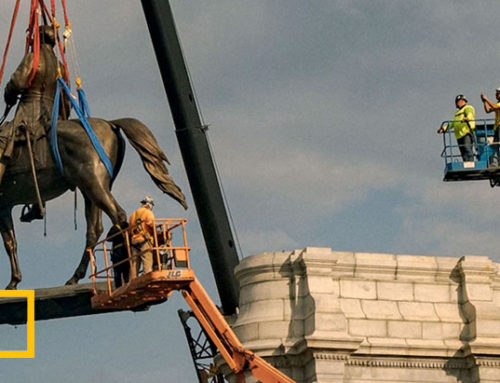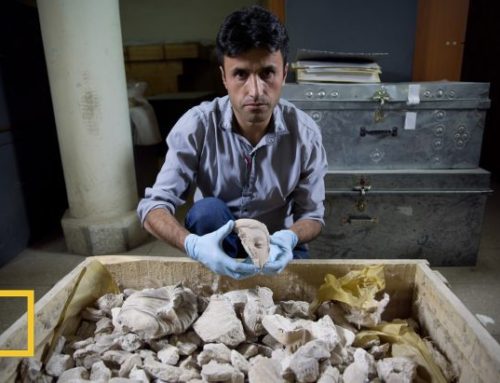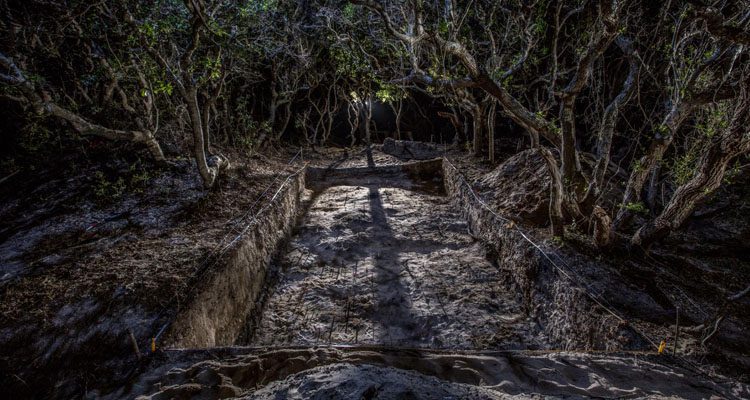
Two decades before Jamestown, settlers arrived in what is now North Carolina. What happened to them is a mystery, but there are some clues.
FROM THE ENGLISH ship Hopewell anchored off the coast of what is now North Carolina, Governor John White watched with elation as a column of smoke rose into the summer dusk.
The plume from Roanoke Island “put us in good hope that some of the colony were there expecting my return out of England,” he wrote later. Three years had passed since the governor had set out from the first English settlement in the New World on what was to be a brief resupply mission, leaving behind more than a hundred men, women, and children. But his return voyage had been delayed again and again by the outbreak of war with Spain. At last, on August 18, 1590, White and a party of sailors waded ashore on Roanoke Island. According to White’s account of events, they spotted fresh footprints but met no one. As the men climbed a sandy bank, they encountered a tree with the carved letters “C R O.” This was, the governor explained, a prearranged code. If the settlers were to leave the island, they should carve their destination into a tree or post. Adding a cross would mean they left in an emergency.
Reaching the abandoned settlement, the governor spotted a post on which “in fair capital letters was graven CROATOAN without any cross or sign of distress.” Yet the post itself was part of a defensive palisade thrown up after White had left—a clear sign that the settlers had prepared for an enemy attack.
Croatoan was the name of both a barrier island to the south and the indigenous people who lived there, Carolina Algonquian speakers closely allied with the European newcomers. One of their young men, Manteo, had traveled twice to London and served as an essential guide, interpreter, and diplomat for the English.
White desperately wanted to reach Croatoan, a mere 50 miles to the south—though he also mentions that the colonists originally intended to move 50 miles inland. A series of setbacks and lack of provisions scuttled his plan to continue the search. On returning to England, he found Sir Walter Raleigh, the colony’s wealthy patron, busy organizing a new venture in Ireland. Without deep pockets to finance a transatlantic expedition on his own, White never returned to the New World. The 115 colonists—including Eleanor and Virginia Dare, White’s daughter and infant grandchild—were all but forgotten, marooned on a distant shore.
Two decades later the English established their first permanent beachhead in the Americas, a hundred miles to the north on the James River, in what is now Virginia. Captain John Smith, the leader of the Jamestown colony, heard from the Indians that men wearing European clothes were living on the Carolina mainland west of Roanoke and Croatoan Islands. Tales of mass slaughter and an enslaved “young maid” circulated in London and Jamestown. Search parties, however, never found any physical proof of the colonists’ fate.
And so it would go for the next 400 years, as one investigation after another into what had happened on Roanoke Island proved fruitless. The absence of evidence spawned wild speculation, hoaxes, and countless conspiracy theories. But in recent years a series of finds at archaeological digs—and a chance discovery at the British Museum—have revealed tantalizing new clues that suggest what happened to the settlers after White departed. Historians, meanwhile, are starting to recognize that Roanoke was more than a passing failure. The effort was, in essence, the Apollo program of Elizabethan England, spanning six years and three major voyages.
The first, in 1584, was a reconnaissance mission. The following year an all-male contingent—with White as expedition artist—defied Spanish claims to North America and arrived on Roanoke hoping to find gold, valuable pharmaceuticals, and a shortcut to the Pacific. Instead they made enemies of their Native American hosts by assassinating their leader. Ragged and hungry, the men caught a ride home less than a year later with a fleet commanded by Sir Francis Drake. The following spring, in 1587, White led a third expedition made up primarily of middle-class Londoners, including his pregnant daughter, Eleanor Dare, as well as 16 other women and nearly a dozen children.
All told, more than a score of oceangoing ships carried hundreds of people across the 16th-century equivalent of interplanetary space. The bold venture dwarfed in size and scope the later—and more renowned—forays to Jamestown and Plymouth, birthed the first corporation in English America, and forged the link between England and the mid-Atlantic coast of North America that seeded both the British Empire and the United States.
“The profound significance of Raleigh’s Virginia voyages to the history and culture of the modern world is often forgotten or undervalued,” writes Neil MacGregor, former director of the British Museum. The museum houses White’s extraordinary paintings, which helped shape Europeans’ conception of the New World and its inhabitants.
Despite the governor’s belief that the settlers went to Croatoan, searchers found no evidence there until after 1993, when a hurricane exposed large amounts of pottery and other remnants of a Native American village.
“We English lost it, so I guess it’s up to us to find it again,” Mark Horton says cheerily. The archaeologist from the University of Bristol stands on the lip of a rectangular hole shaded by gnarled live oaks. Just over the wooded dune, Pamlico Sound laps rhythmically against the North Carolina beach.
In the 1580s a nearby inlet made this an ideal spot to gather scallops and oysters, and catch turtles and fish. Patches of fertile soil were suitable for growing corn, squash, and beans. When the inlet closed a century or so after White left, this became part of Hatteras Island, a long boomerang of blowing sand and maritime forest angled deep into the Atlantic.
A local organization, the Croatoan Archaeological Society, sponsors an annual dig led by Horton. Since 2013, the team has uncovered a variety of Old World objects mixed in with Native American artifacts in the heart of a village. They include the remains of what appears to be a gentleman’s dress sword called a rapier, along with some scraps of European copper, the barrel of a gun, lead shot, and a piece of drawing slate with its lead pencil.
Horton suspects the slate might have belonged to White, who may have used it to make sketches of the local people. The haul is one of the New World’s few troves of arguably Elizabethan artifacts, all in the very place Governor White had believed the lost colonists had gone.
Though nearing retirement age, Horton has the pudgy red cheeks and keen enthusiasm of an English schoolboy. As we talk, a team member nearby hands a bucket heavy with muck to a volunteer, who pours it into a box with a fine-mesh screen. She hoses down the material and swiftly plucks out a minuscule baby blue bead made in Italy. Later that day a thin, round object surfaces that was manufactured in Antwerp, Belgium, in 1648 to weigh the silver in a Hungarian coin called a ducat. By the mid- to late 17th century the new global economy encompassed even isolated Croatoan Island.
“I would never argue that they all end up here,” Horton says of the colonists. “But this is where they would be welcomed and supported. I suspect they would have sent the women and children here; it’s almost certain this would be where Virginia Dare turns up.”
Yet most of the objects that appear Elizabethan were found among other material, such as tiny glass beads and broken pottery that likely date to more than a half century after White’s failed rescue attempt. “It’s deeply problematic that this stuff turns up two generations later,” Horton admits. He suggests that the older Elizabethan objects may have been kept by the children or grandchildren of abandoned settlers who may have assimilated with the Croatoan. But even some members of the excavation team suspect the material could have arrived through trade with later English settlements.
On the other hand, animal bones from trash heaps suggest an abrupt dietary switch from fish and turtles to deer and birds—evidence that could hint at indigenous people using European guns early in the contact period, guns the lost colonists may have provided.
There’s no doubt, however, about the age and authenticity of the watercolors White made during his stint as expedition artist in 1585. Among these is a colorful map of eastern North Carolina, gaily decorated with English ships and Indian canoes. The chart, based on careful measurements by the expedition’s brilliant scientist Thomas Harriot, is also remarkably accurate.
Brent Lane, who taught heritage economics at the University of North Carolina at Chapel Hill, grew up fascinated by Lost Colony legends and owns a modern copy of White’s watercolor map. In 2011 he became curious about two faint patches on his copy. The British Museum initially was slow to respond to his request to probe what lay under the original’s coverings. He persisted.
When the curators put the painting on a light table three months later, the star-shaped symbol of a fort appeared under one patch. The location of the fort was just as startling: It lay not on Roanoke Island but some 50 miles away, at the head of Albemarle Sound—matching White’s mention that the colonists planned to relocate “fifty miles into the main.” And on top of this patch was the barely perceptible outline of a fort as well, drawn in what may have been invisible ink made with urine—a hint that the patch was meant to conceal a secret rather than fix an error.
“Every generation in the last 400 years has taken this search on,” Lane told a crowded press conference announcing the discovery. But “none of them had this clue. This is really a solid lead.”
Archaeologists from the First Colony Foundation, a North Carolina nonprofit devoted to Roanoke-related archaeology, set out to investigate the area indicated on the chart. They focused on a piece of land beside a cove perfect for hiding a ship from Spanish scouts. In a nod to the cloak-and-dagger nature of the find, they named it Site X.
“No social media!” barks archaeologist Nicholas Luccketti when I arrive at the site one hot summer morning, having promised not to reveal its precise location. “No Facebook, no tweeting, no texting!” Workers in a half dozen trenches are tossing dirt into buckets that in turn are dumped into mesh screens where the dirt is closely examined for the smallest artifacts.
Luccketti, a short, stocky Virginian, is on edge. He fears some of the excavation volunteers have tipped off potential looters. Since work began in 2012, the team has retrieved L-shaped bits of metal, possibly used for stretching out a tent or animal skin, as well as an aglet, a tiny tube used to secure the end of a wool lace. A brass buckle and lead seal also could date to Elizabethan times.
The archaeologist believes his ace in the hole is a few dozen broken bits of pottery. Standing at a plastic table in the middle of the field, he pulls a triangular piece of green pottery from a plastic bag. The outer surface is green and smooth, and the inner side pink and rougher. The ceramic was manufactured on the boundary between Surrey and Hampshire Counties in southern England and is therefore called Border ware. To be honest, it’s not much to look at. Luccketti reads my mind.
“The mundane nature of this is what makes it important,” he says. “If it was a pretty object, then the Indians might collect it.” In other words, this English pottery was probably left where it fell rather than reused by Native Americans. Luccketti feels sure I’m holding part of a bowl used by a lost colonist. “We think this was where they came after Governor White left,” he concludes confidently.
His conviction hinges on a logical but arcane argument. At early English settlements such as Jamestown, Border ware made up a hefty percentage of the pottery, but over time that percentage rapidly declined. By the time the English colonists arrived in the Site X area about 1660, Border ware was relatively rare. Yet here it’s common.
Other archaeologists remain skeptical. They insist that Luccketti must come up with other lines of evidence—such as the grave of an Elizabethan colonist—to clinch his case. When I see Luccketti in late 2017, after a final excavation at Site X, he’s not as sanguine.
“We don’t know exactly what we’ve got here,” the archaeologist says ruefully. “It remains a bit of an enigma.”
CONTESTED CLUES FROM A NATIVE AMERICAN VILLAGE
Throughout colonial North America, most of the English captured by Indians or who deserted refused to return, even if given the chance. Unlike Europeans, Native Americans in the colonial era typically welcomed men, women, and children of any origin into their ranks. Though some warrior-age men were killed and others enslaved, the vast majority were accepted as full members of the tribe.
In such small-scale societies, there was power in numbers, and newcomers were swiftly taught Indian language and skills that replaced their European ways. If the lost colonists followed this path and assimilated quickly into Carolina Algonquian society, as many historians believe, they may have left evidence in the form of DNA in their descendants.
When explorer John Lawson visited the area in 1701, he heard that the Hatteras Indians claimed that “several of their ancestors were white people … the truth of which is confirmed by gray eyes being found frequently amongst these Indians, and no others.” He assumed that the lost colonists “conform’d themselves to the manners of their Indian relations.”
During the past decade, Michigan-based computer scientist Roberta Estes has been gathering genetic data to test Lawson’s theory. “You can use DNA to look through a periscope that goes far back in history,” she says. But the image remains stubbornly fuzzy.
Since no one has pinpointed modern English descended from colonist relatives, Estes has nothing to compare with her samples from current-day descendants of eastern North Carolinians. Extracting DNA from 16th-century bones on Roanoke Island, Hatteras, or at Site X could provide a reliable link between the settlers and their descendants, but that genetic material remains elusive.
“I don’t want people to come away with the idea that DNA is a magic bullet,” adds Estes, a dark-haired woman with indigenous ancestors. “But it could solve some of this mystery by inferring that the colonists survived.” New pieces of the puzzle, including English genealogical records and excavated human remains that yield DNA, could emerge in time.
On Hatteras, some members of old families maintain that their ancestors were Native Americans. Real estate records indicate that a small community of Indians remained on the island as late as 1788, two centuries after the Roanoke settlers arrived, but there is no sign of Indian traditions that persisted into the 20th century. Estes also has yet to find evidence of Native American DNA among today’s long-term inhabitants.
Some of the Indians, however, moved to the mainland swamps to the west to join Algonquian cousins known in the 18th century as the Machapunga. This area, still boggy backcountry more plentiful in wildlife than people, is where John Smith was told Europeans could be found. Incoming Europeans and Africans subsequently mixed with the Machapunga. In the mid-19th century, racial purity laws designated most nonwhite North Carolinians as black. That had the effect of obliterating the intricate distinctions of mixed ethnicities that still characterize the people in the state’s thinly populated east.
Early in the 20th century a visiting anthropologist identified a group of people called the Machapunga living on the mainland. Though they’d lost their native tongue and were considered black, they retained distinctive Algonquian ways of cooking and making baskets and nets. By the 1920s, drawn by better opportunities, a hundred or so of this group had moved to Manteo, the seat of Dare County, on Roanoke Island. “Today, the ancestry of these people is so predominately Negroid that any Indian blood is thoroughly disguised,” another anthropologist wrote about Manteo’s Machapunga in 1960.
If the lost colonists melted into the Croatoan and then the Machapunga, their fate is rich with historical irony. By the late 19th century, a popular myth imagined Virginia Dare as a beautiful blond-haired and blue-eyed virgin in a wilderness filled with dark savages. She also was a powerful symbol of white supremacy in the Jim Crow South. If she lived to have a family of her own, the most likely descendants of this fancied forest damsel are the African Americans now living within a few miles of her birthplace.
That would mean that even before the first permanent English settlement at Jamestown, the American melting pot already was bubbling with a diverse genetic mixture of English and Native Americans—and possibly Africans as well. Sir Francis Drake liberated hundreds of black slaves, likely including Muslims, in Caribbean raids in 1586. Many historians argue that he dropped them at Roanoke Island when he rescued the all-male colony and that they intermingled with Carolina Algonquian society.
One rainy spring morning I visit the chief of the Roanoke-Hatteras tribe. Marilyn Berry Morrison meets me at the door of her suburban home in Chesapeake, Virginia. Though she looks African-American, her Indian-print dress and intricate ponytails braided in leather straps proclaim her identity.
“I claim Native American based on tradition,” Morrison explains, though she doesn’t deny her mixed white and black heritage. Her tribe has yet to win state or federal status, and family DNA consists of only a smattering of Indian genes. She’s nevertheless adamant that her parents and grandparents retained Algonquian ways to fish, heal, and cook.
I ask her about the link to the Roanoke settlers. “We were the Lost Colony,” she responds. “Our surnames, like ‘Berry,’ appear on the colonists’ list. We are the original melting pot.”
But hers is not a sweet tale of openhearted assimilation. “We killed the men and took the women and children,” she adds matter-of-factly.
Morrison pulls out a thick family album and flips through the pages. Her ancestors’ skin colors range from ivory to ebony. My eyes fall on one name that lacks a photograph. “She was my great-great-grandmother,” Morrison says. “She was from Roanoke Island.” Her name was Virginia Dare Bowser Tillet.
Leaving Morrison’s house, it occurs to me that our 400-year-old obsession with the Lost Colony isn’t just about what happened to a group of English migrants on a remote island. In a nation fractured by views on race, gender, and immigration, we’re still struggling with what it means to be American. Maybe, I think, we’re all latter-day John Whites, searching for clues in our distant past to guide us through an unsettling present and into the uncertain future.
